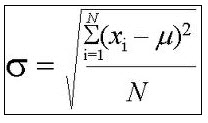Sample Standard Deviation Calculator
Instructions: In order to use this sample standard deviation calculator (SD), please provide the sample data below and this solver will provide step-by-step calculation:
More About this Sample Standard Deviation Calculator
The sample standard deviation (usually abbreviated as SD or St. Dev. or simply \(s\)) is one of the most commonly used measures of dispersion, that is used to summarize the data into one numerical value that expresses our disperse the distribution is. When we say "disperse", we mean how far are the values of distribution relative to the center.
How do you calculate the sample standard deviation?
Let \(\{X_1, X_2, ..., X_n\}\) be the sample data. The following formula is used to compute the sample standard deviation:
\[ s = \sqrt{\frac{1}{n-1}\sum_{i=1}^n (X_i-\bar X)}\]Observe that the formula above requires to compute the sample mean first, before starting the calculation of the sample standard deviation, which could be inconvenient if you only want to compute the standard deviation. There is an alternative formula that does not use the mean, which is shown below: \[ s = \sqrt{\frac{1}{n-1}\left( \sum_{i=1}^n X_i^2 - \frac{1}{n} \left(\sum_{i=1}^n X_i\right)^2 \right)} \]
One of the advantages of this calculator is that it will calculate the standard deviation for you with work, so that you can follow all the steps.
Example of calculation of the standard deviation
Example: For example, assume that the sample data is \(\{ 1, 2, 5, 8, 10\}\), then, the sample SD is computed as follows:
\[ s = \sqrt{\frac{1}{n-1}\left( \sum_{i=1}^n X_i^2 - \frac{1}{n} \left(\sum_{i=1}^n X_i\right)^2 \right)}\] \[ = \sqrt{\frac{1}{5-1}\left( 1^2+2^2+5^2+8^2+10^2 - \frac{1}{5} (1+2+5+8+10 )^2 \right)} = 3.8341 \]The sample standard deviation is typically used as a representative measure of the dispersion of the distribution. But, the problem with the sample standard deviation is that it is sensitive to extreme values and outliers. If what you need is to compute all the basic descriptive measures, including sample mean, variance, standard deviation, median, and quartiles please check this complete descriptive statistics calculator .
Population versus Sample Values
Please notice that you are computing the sample standard deviation from a sample of data. In order to compute the population standard deviation, you will need to have ALL the data from the population. And also, when computing the population st. deviation, the formula will have a \(n\) in the denominator instead of a \(n-1\). The reasons for this go beyond the scope of this tutorial.
Sometimes, you need to estimate the standard deviation, but you maybe do not have the sample data, or the data are incomplete. In that case, you can use the rule of thumb to compute the standard deviation .
Difference between the standard deviation and standard error
Standard error corresponds to the standard deviation of the sampling distribution of sample means. This standard error calculator will compute the standard error for the case you know the standard deviation population, and you want to compute the standard deviation of sample means, with a given sample size \(n\).

